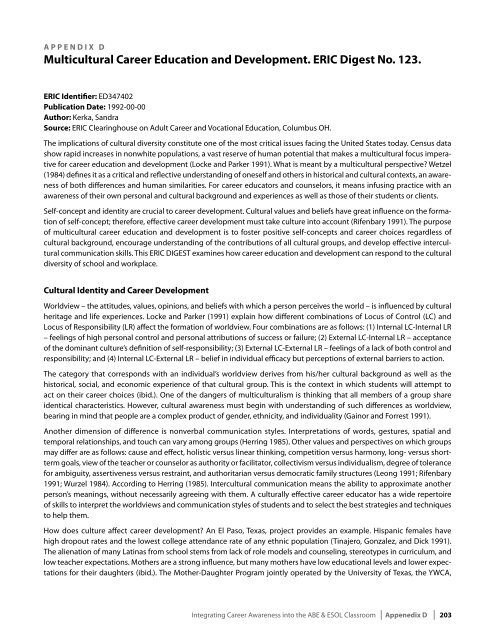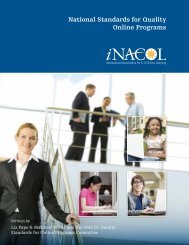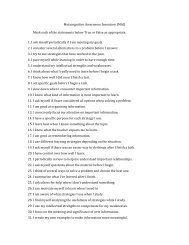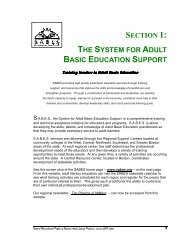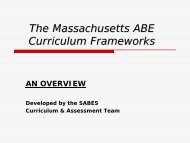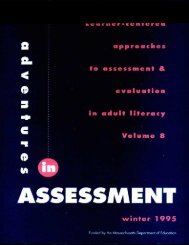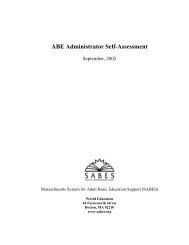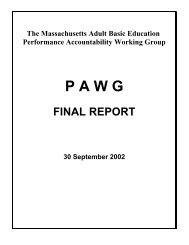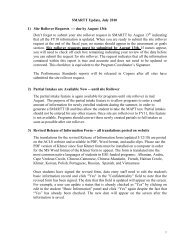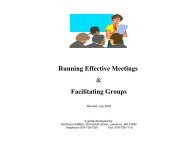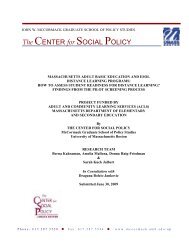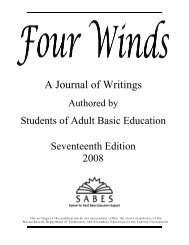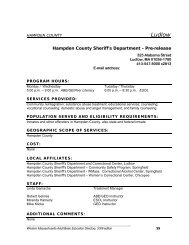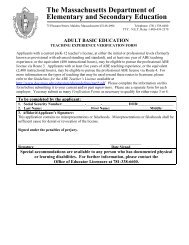Integrating Career Awareness into the ABE/ESOL Classroom - SABES
Integrating Career Awareness into the ABE/ESOL Classroom - SABES
Integrating Career Awareness into the ABE/ESOL Classroom - SABES
- No tags were found...
You also want an ePaper? Increase the reach of your titles
YUMPU automatically turns print PDFs into web optimized ePapers that Google loves.
A P P E N D I X D<br />
Multicultural <strong>Career</strong> Education and Development. ERIC Digest No. 123.<br />
ERIC Identifier: ED347402<br />
Publication Date: 1992-00-00<br />
Author: Kerka, Sandra<br />
Source: ERIC Clearinghouse on Adult <strong>Career</strong> and Vocational Education, Columbus OH.<br />
The implications of cultural diversity constitute one of <strong>the</strong> most critical issues facing <strong>the</strong> United States today. Census data<br />
show rapid increases in nonwhite populations, a vast reserve of human potential that makes a multicultural focus imperative<br />
for career education and development (Locke and Parker 1991). What is meant by a multicultural perspective? Wetzel<br />
(1984) defines it as a critical and reflective understanding of oneself and o<strong>the</strong>rs in historical and cultural contexts, an awareness<br />
of both differences and human similarities. For career educators and counselors, it means infusing practice with an<br />
awareness of <strong>the</strong>ir own personal and cultural background and experiences as well as those of <strong>the</strong>ir students or clients.<br />
Self-concept and identity are crucial to career development. Cultural values and beliefs have great influence on <strong>the</strong> formation<br />
of self-concept; <strong>the</strong>refore, effective career development must take culture <strong>into</strong> account (Rifenbary 1991). The purpose<br />
of multicultural career education and development is to foster positive self-concepts and career choices regardless of<br />
cultural background, encourage understanding of <strong>the</strong> contributions of all cultural groups, and develop effective intercultural<br />
communication skills. This ERIC DIGEST examines how career education and development can respond to <strong>the</strong> cultural<br />
diversity of school and workplace.<br />
Cultural Identity and <strong>Career</strong> Development<br />
Worldview – <strong>the</strong> attitudes, values, opinions, and beliefs with which a person perceives <strong>the</strong> world – is influenced by cultural<br />
heritage and life experiences. Locke and Parker (1991) explain how different combinations of Locus of Control (LC) and<br />
Locus of Responsibility (LR) affect <strong>the</strong> formation of worldview. Four combinations are as follows: (1) Internal LC-Internal LR<br />
– feelings of high personal control and personal attributions of success or failure; (2) External LC-Internal LR – acceptance<br />
of <strong>the</strong> dominant culture’s definition of self-responsibility; (3) External LC-External LR – feelings of a lack of both control and<br />
responsibility; and (4) Internal LC-External LR – belief in individual efficacy but perceptions of external barriers to action.<br />
The category that corresponds with an individual’s worldview derives from his/her cultural background as well as <strong>the</strong><br />
historical, social, and economic experience of that cultural group. This is <strong>the</strong> context in which students will attempt to<br />
act on <strong>the</strong>ir career choices (ibid.). One of <strong>the</strong> dangers of multiculturalism is thinking that all members of a group share<br />
identical characteristics. However, cultural awareness must begin with understanding of such differences as worldview,<br />
bearing in mind that people are a complex product of gender, ethnicity, and individuality (Gainor and Forrest 1991).<br />
Ano<strong>the</strong>r dimension of difference is nonverbal communication styles. Interpretations of words, gestures, spatial and<br />
temporal relationships, and touch can vary among groups (Herring 1985). O<strong>the</strong>r values and perspectives on which groups<br />
may differ are as follows: cause and effect, holistic versus linear thinking, competition versus harmony, long- versus shortterm<br />
goals, view of <strong>the</strong> teacher or counselor as authority or facilitator, collectivism versus individualism, degree of tolerance<br />
for ambiguity, assertiveness versus restraint, and authoritarian versus democratic family structures (Leong 1991; Rifenbary<br />
1991; Wurzel 1984). According to Herring (1985). Intercultural communication means <strong>the</strong> ability to approximate ano<strong>the</strong>r<br />
person’s meanings, without necessarily agreeing with <strong>the</strong>m. A culturally effective career educator has a wide repertoire<br />
of skills to interpret <strong>the</strong> worldviews and communication styles of students and to select <strong>the</strong> best strategies and techniques<br />
to help <strong>the</strong>m.<br />
How does culture affect career development? An El Paso, Texas, project provides an example. Hispanic females have<br />
high dropout rates and <strong>the</strong> lowest college attendance rate of any ethnic population (Tinajero, Gonzalez, and Dick 1991).<br />
The alienation of many Latinas from school stems from lack of role models and counseling, stereotypes in curriculum, and<br />
low teacher expectations. Mo<strong>the</strong>rs are a strong influence, but many mo<strong>the</strong>rs have low educational levels and lower expectations<br />
for <strong>the</strong>ir daughters (ibid.). The Mo<strong>the</strong>r-Daughter Program jointly operated by <strong>the</strong> University of Texas, <strong>the</strong> YWCA,<br />
<strong>Integrating</strong> <strong>Career</strong> <strong>Awareness</strong> <strong>into</strong> <strong>the</strong> <strong>ABE</strong> & <strong>ESOL</strong> <strong>Classroom</strong> | Appenedix D | 203


